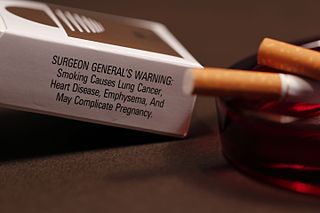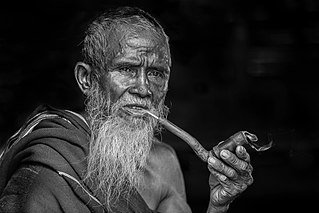
Opium is dried latex obtained from the seed capsules of the opium poppy Papaver somniferum. Approximately 12 percent of opium is made up of the analgesic alkaloid morphine, which is processed chemically to produce heroin and other synthetic opioids for medicinal use and for the illegal drug trade. The latex also contains the closely related opiates codeine and thebaine, and non-analgesic alkaloids such as papaverine and noscapine. The traditional, labor-intensive method of obtaining the latex is to scratch ("score") the immature seed pods (fruits) by hand; the latex leaks out and dries to a sticky yellowish residue that is later scraped off and dehydrated.

The prohibition of drugs through sumptuary legislation or religious law is a common means of attempting to prevent the recreational use of certain intoxicating substances.

Tobacco smoking is the practice of burning tobacco and ingesting the resulting smoke. The smoke may be inhaled, as is done with cigarettes, or simply released from the mouth, as is generally done with pipes and cigars. The practice is believed to have begun as early as 5000–3000 BC in Mesoamerica and South America. Tobacco was introduced to Eurasia in the late 17th century by European colonists, where it followed common trade routes. The practice encountered criticism from its first import into the Western world onwards but embedded itself in certain strata of a number of societies before becoming widespread upon the introduction of automated cigarette-rolling apparatus.

The Opium Wars were two conflicts waged between China and Western powers during the mid-19th century.

Taiwan is an island located off the coast of Fujian in mainland China. The Chinese and Taiwanese people have a long history together, with the first Han Chinese settlers arriving in Taiwan in the seventeenth century. The Japanese empire acquired Taiwan following its cession from Qing dynasty China in the Treaty of Shimonoseki (1895) at the conclusion of the First Sino-Japanese War. This period of Japanese rule of Taiwan lasted until the surrender of Japan. During this period the colonial government of Japan initiated major policies to reduce the consumption of opium and opium derived products with much regarded success from contemporary sources both from the Japanese Colonial government and international sources.

The history of tea spreads across many cultures throughout thousands of years. The tea plant Camellia sinensis is native probably originated in the borderlands of southwestern China and northern Myanmar. One of the earliest accounts of tea drinking is dated back to China's Shang dynasty, in which tea was consumed in a medicinal concoction. An early credible record of tea drinking dates to the 3rd century AD, in a medical text written by Chinese physician Hua Tuo. It first became known to the western world through Portuguese priests and merchants in China during the early 16th century. Drinking tea became popular in Britain during the 17th century. To compete with the Chinese monopoly on tea, the British East India Company introduced commercial tea production to British India.

Pipe smoking is the practice of tasting the smoke produced by burning a substance, most commonly tobacco or cannabis, in a pipe. It is the oldest traditional form of smoking.

Snuff is a type of smokeless tobacco product made from finely ground or pulverized tobacco leaves. It is snorted or "sniffed" into the nasal cavity, delivering nicotine and a flavored scent to the user. Traditionally, it is sniffed or inhaled lightly after a pinch of snuff is either placed onto the back surface of the hand, held pinched between thumb and index finger, or held by a specially made "snuffing" device.

The smoking age is the minimum legal age required to purchase or use tobacco or cannabis products. Most countries have laws that forbid sale of tobacco products to persons younger than certain ages, usually the age of majority.

Smoking is a practice in which a substance is combusted and the resulting smoke is typically inhaled to be tasted and absorbed into the bloodstream of a person. Most commonly, the substance used is the dried leaves of the tobacco plant, which have been rolled with a small rectangle of paper into an elongated cylinder called a cigarette. Other forms of smoking include the use of a smoking pipe or a bong.

The history of smoking dates back to as early as 5000 BC in the Americas in shamanistic rituals. With the arrival of the Europeans in the 16th century, the consumption, cultivation, and trading of tobacco quickly spread. The modernization of farming equipment and manufacturing increased the availability of cigarettes following the reconstruction era in the United States. Mass production quickly expanded the scope of consumption, which grew until the scientific controversies of the 1960s, and condemnation in the 1980s.
Zailiism or Liism (理教), also known as the Baiyidao or Bafangdao, is a Chinese folk religious sect of north China, founded in the 17th century by Yang Zai. It claims a Taoist identity and is centered on the worship of Guanyin as the incarnation of the principle of the universe, the "Only God of the Unlimited".

Smoking in Syria is steadily increasing in popularity amongst the Syrian population, mainly in the forms of cigarettes or narghiles. In Syria, the General Organization of Tobacco manages the growth and exportation of tobacco products. Syrians collectively spend about $600 million per year on tobacco consumption. As of 2010, 20% of women and 60% of men smoke and 98% of the overall population is affected by passive smoking. Narghiles and cigarettes are the two main forms of tobacco consumption. Despite the assumption that smoking, specifically the narghile, is embedded in Syrian culture, this phenomenon has only recently become widespread. Health officials are currently working on smoking cessation programs and policies, to remove this idea that smoking in Syria is an essential part of the culture, to educate regarding health effects, and to prevent citizens from smoking in public places.

Smoking in India is one of the oldest industries and provides employment to more than five million people directly and indirectly. India is the second-largest producer of tobacco in the world. Smoking has been known since at least 2000 BC when cannabis was smoked and is first mentioned in the Atharvaveda. Fumigation (dhupa) and fire offerings (homa) are prescribed in the Ayurveda for medical purposes and have been practiced for at least 3,000 years while smoking, dhumrapana has been practiced for at least 2,000 years. Tobacco was introduced to India in the 17th century. It later merged with existing practices of smoking.

The history of opium in China began with the use of opium for medicinal purposes during the 7th century. In the 17th century the practice of mixing opium with tobacco for smoking spread from Southeast Asia, creating a far greater demand.

Cannabis in India has been known to be used at least as early as 2000 BCE. In Indian society, common terms for cannabis preparations include charas (resin), ganja (flower), and bhang, with Indian drinks such as bhang lassi and bhang thandai made from bhang being one of the most common legal uses.

Although Cannabis use is illegal in Egypt, it is often used privately by many. Law enforcements are often particularly lax when it comes to cannabis smokers, and its use is a part of the common culture for many people in Egypt. However, Large-scale smuggling of cannabis is punishable by death, while penalties for possessing even small amounts can also be severe. Despite this, these laws are not enforced in many parts of Egypt, where cannabis is often consumed openly in local cafes.

Tobacco smoking is popular in North Korea and culturally acceptable among men, but not for women. As of 2019, some 43.6% of men are reported to smoke daily, whilst in contrast only 4.5% of women smoke daily, with most of these being older women from rural areas. Smoking is a leading cause of death in North Korea, and as of 2021 mortality figures indicate that 14.2% of North Koreans die due to smoking-related causes, which is the 6th highest rate after China, Greenland, Kiribati, Denmark and Micronesia. There are tobacco control programs in North Korea, and although smoking was not prohibited in all public spaces, the smoking rates have declined since their peak in the 2000s.

Khamr is an Arabic word for wine or intoxicant. It is variously defined as alcoholic beverages, wine or liquor.

Opium was first recorded in Singapore by a written document that recorded Stamford Raffles gifting opium to a local ruler in 1819 to establish Singapore. Opium then became accessible through trading in the 19th century. It was one of the most traded goods along the Sea Trade route after the end of the Opium Wars. With the rise of opium farms in Singapore, they acted as the middleman that helped to process raw opium imported from British India, Persia, and Turkey to consumable opium and retail them to the Chinese coolies in local. In 1946, opium, including the tools, and opium dens were completely banned in Singapore. To treat the opium addicts, an Opium Treatment Centre was opened in 1955 and in 1989, and the Singapore government extended the death penalty for opium traffickers.

















